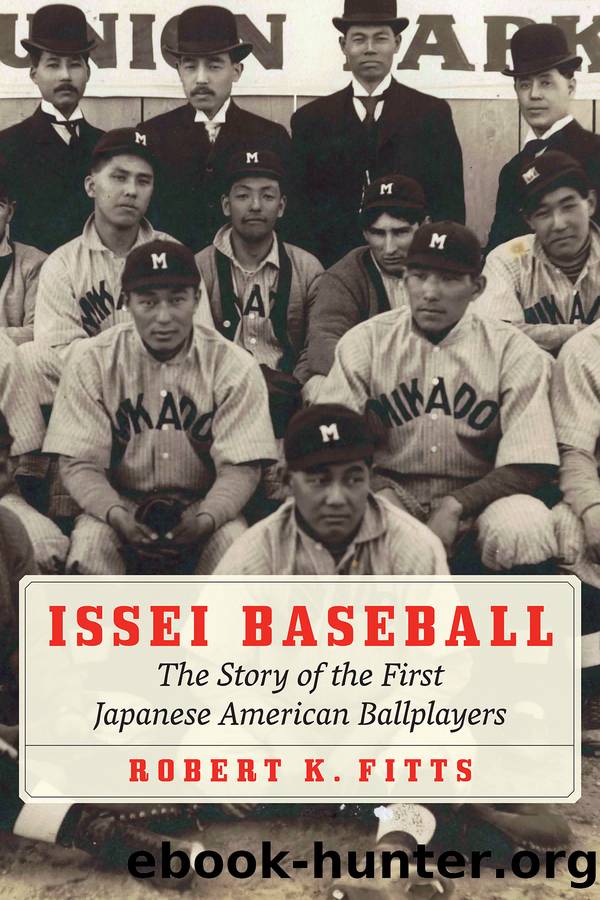Issei Baseball by Robert K. Fitts

Author:Robert K. Fitts [Fitts, Robert K.]
Language: eng
Format: epub
Tags: SPO003030 Sports & Recreation / Baseball / History, HIS036060 History / United States / 20th Century
Publisher: Nebraska
Newspapers across the United States, from the New York Times to the Laredo (TX) Weekly Times, followed Wasedaâs progress, noting game results and running occasional articles of various lengths. Starting in mid-May many papers began carrying a series of articles featuring the Waseda players titled âJaps Tell How to Play Ball.â Each piece contained a short essay written by a Waseda player on how to play his particular position and a large photograph of the player. Manasoba Fukubori explained that a third baseman must be courageous and agile; ace pitcher Sutekichi Matsuda wrote, âOf three great virtues in pitching in baseball, curve, velocity and accuracy, I find the one greatest to be admired is accuracyâ; and Goro Mikami noted that âfearlessness and much confidence help the batter.â20 After fifteen days in California the Waseda squad headed east by train toward Chicago, with stops for games in Ogden, Utah, and Boulder, Colorado.
A week after the Waseda ball club left California, the Keio University team arrived in San Francisco. Established in 1858, twenty-four years before archrival Waseda, Keio was considered by most experts to be Japanâs top team in 1911. The two clubs, however, had not met on the diamond for five years as the schools had canceled all games for fear the rivalry would lead to student riots.
Keio had worked hard to surpass Waseda as the nationâs top team. The players traveled to Hawaii in the summer of 1908, where they played local teams and Californiaâs University of Santa Clara. They returned to Japan in time to take five games from the visiting Great White Fleet and three from the University of Washington. In 1909 Keio invited the University of Wisconsinâs varsity team to Japan. Keio shocked the Americans by winning the first three games (by one run in each) before dropping the final game, 8â0. The second game went eighteen innings, the longest game in Japan at the time, before Keio pushed across the winning run. Nineteen-year-old Kazuma Sugase pitched all four games for Keio, including all eighteen innings of the second meeting, when he struck out sixteen and allowed just five hits. The son of a German father and Japanese woman, Sugase would become Japanâs top pitcher and be singled out by John McGraw as âone of the greatest all-around athletes in Japan.â21
The Keio team, however, was not satisfied with its victories over Wisconsin. The players knew that they still had much to learn before they could tackle the top American university teams. In December 1910 Keio invited Arthur âTilleyâ Shafer (often spelled Schaeffer) to Japan to coach the team. The twenty-one-year-old Shafer had attended St. Vincentâs in Los Angeles, when Waseda played against the school in 1905, and during a trip with Santa Clara College to Hawaii in 1908 he played against Keio. In 1909 he signed with the New York Giants and spent the majority of two seasons on McGrawâs bench, hitting just .179 in 1909 and .190 in 1910. Contemplating his future in the fall of 1910, Shafer wrote to offer his services to Keio.
Download
This site does not store any files on its server. We only index and link to content provided by other sites. Please contact the content providers to delete copyright contents if any and email us, we'll remove relevant links or contents immediately.
| Baseball | Basketball |
| Boxing, Wrestling & MMA | Football |
| Golf | Hockey |
| Soccer |
Imperfect by Sanjay Manjrekar(5750)
Wiseguy by Nicholas Pileggi(5618)
The Body: A Guide for Occupants by Bill Bryson(4895)
Tuesdays with Morrie by Mitch Albom(4609)
Unstoppable by Maria Sharapova(3442)
Not a Diet Book by James Smith(3302)
Crazy Is My Superpower by A.J. Mendez Brooks(3277)
Into Thin Air by Jon Krakauer(3268)
The Mamba Mentality by Kobe Bryant(3157)
The Fight by Norman Mailer(2809)
Finding Gobi by Dion Leonard(2726)
Tuesdays With Morrie by Mitch Albom(2636)
The Ogre by Doug Scott(2606)
My Turn by Johan Cruyff(2532)
Unstoppable: My Life So Far by Maria Sharapova(2423)
Accepted by Pat Patterson(2272)
Everest the Cruel Way by Joe Tasker(2215)
Open Book by Jessica Simpson(2185)
Borders by unknow(2155)
